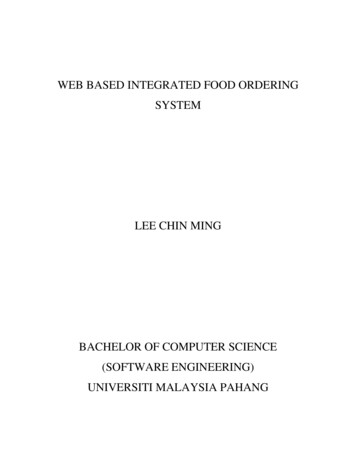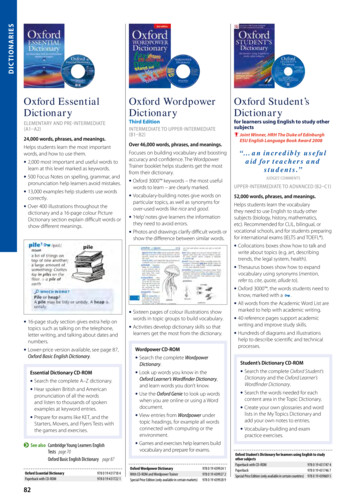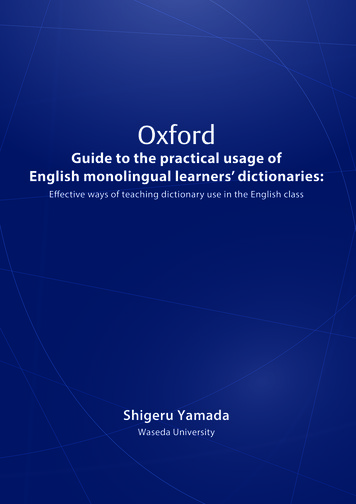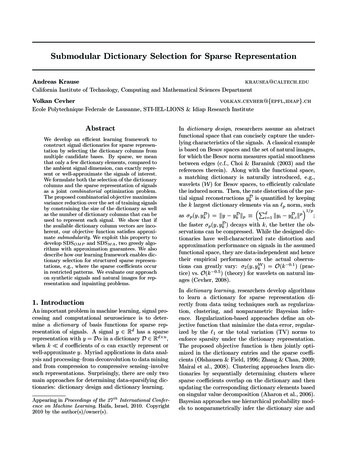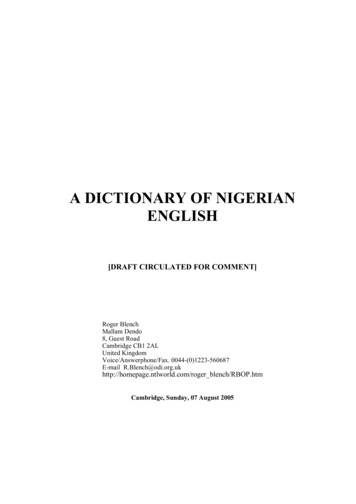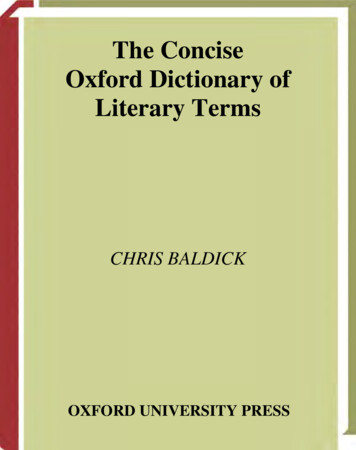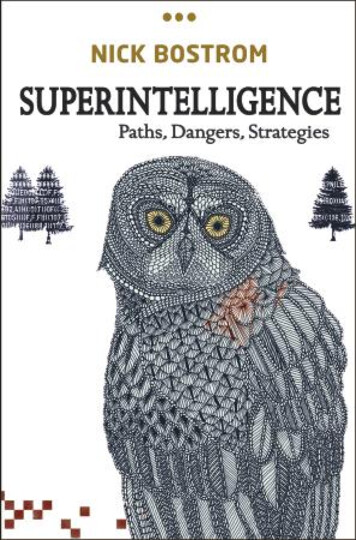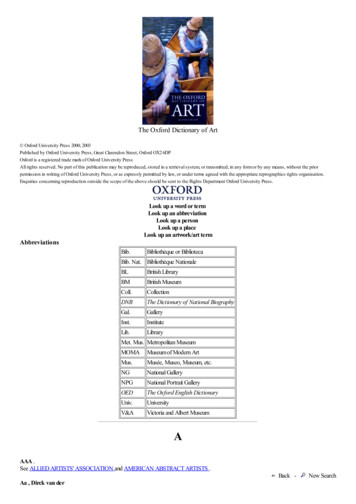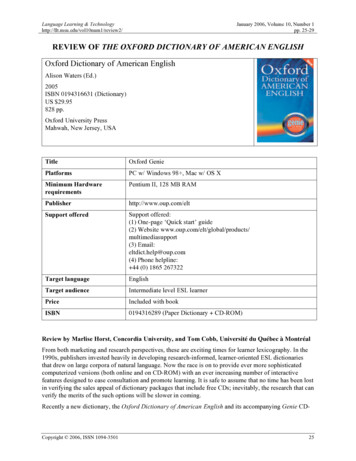
Transcription
Language Learning & uary 2006, Volume 10, Number 1pp. 25-29REVIEW OF THE OXFORD DICTIONARY OF AMERICAN ENGLISHOxford Dictionary of American EnglishAlison Waters (Ed.)2005ISBN 0194316631 (Dictionary)US 29.95828 pp.Oxford University PressMahwah, New Jersey, USATitleOxford GeniePlatformsPC w/ Windows 98 , Mac w/ OS XMinimum HardwarerequirementsPentium II, 128 MB RAMPublisherhttp://www.oup.com/eltSupport offeredSupport offered:(1) One-page ‘Quick start’ guide(2) Website 3) Email:eltdict.help@oup.com(4) Phone helpline: 44 (0) 1865 267322Target languageEnglishTarget audienceIntermediate level ESL learnerPriceIncluded with bookISBN0194316289 (Paper Dictionary CD-ROM)Review by Marlise Horst, Concordia University, and Tom Cobb, Université du Québec à MontréalFrom both marketing and research perspectives, these are exciting times for learner lexicography. In the1990s, publishers invested heavily in developing research-informed, learner-oriented ESL dictionariesthat drew on large corpora of natural language. Now the race is on to provide ever more sophisticatedcomputerized versions (both online and on CD-ROM) with an ever increasing number of interactivefeatures designed to ease consultation and promote learning. It is safe to assume that no time has been lostin verifying the sales appeal of dictionary packages that include free CDs; inevitably, the research that canverify the merits of the such options will be slower in coming.Recently a new dictionary, the Oxford Dictionary of American English and its accompanying Genie CD-Copyright 2006, ISSN 1094-350125
Marlise Horst & Tom CobbReview of The Oxford Dictionary of American EnglishROM software, entered the fray. This dictionary for intermediate-level learners of English has the clear,uncrowded page format we have come to expect in ESL dictionaries, as well as many of the otherwelcome features of its competitors, such as color print and a wealth of illustrations. But since the mainclaim for innovation appears to be the electronic version, we will concentrate our review on theaccompanying CD-ROM.The Genie software that accompanies this new dictionary bills itself as "amazing technology amazinglyeasy to use," a claim that proved justified to the less technology-savvy of the two authors. She had thetool up and running in minutes. Once installed, the tool is indeed easy to use. Double click on the Genieicon, and what looks like the small hand-held electronic dictionary beloved by many ESL learners appearson the computer screen (see Figure 1). Unlike the other ESL dictionary software we examined for thisreview (Summers, 2003, Longman Dictionary of Contemporary English, CD-ROM), the Genie interfacedoes not take up large amounts of screen space (though the Longman screen can be squeezed down ifusers explore). Once opened, Genie simply hovers unobtrusively in the upper left-hand corner of any textone might be reading or writing, waiting to be called on. One can consult Genie in the usual type-andenter way, or amazingly, by simply pointing the mouse at a word to be searched in the text (we testedboth Microsoft WordTM and html documents). The word’s definition appears instantly in Genie’s display– no typing, or even clicking, is needed. If an inflected form like chunks is selected, the user is takendirectly to the headword "chunk." Then, should a word in the defining language or example sentence beunfamiliar (e.g., floating in the example chunks of ice floating in the lake), a double click on the problemitem brings up a definition of "float." Once at "float", the user can chose between two types of go-backarrows. One returns the user to the starting point ("chunk") while the other is a next-on-the-shelf optionthat shows entries listed near "float" (in this case "flit" and "flirt").Figure 1. From chunks in WordTM to "chunk" in GenieThe sheer effortlessness of using Genie raises the question of whether this is actually a good thing forEnglish language learners. Studies of traditional dictionary use point to the word-learning effects ofsearches that engage learners in cognitively demanding processes, such as recalling spellings, searchingalphabetically, holding information in memory, and scanning a page of near matches to find the targetedword (Chun & Payne, 2004; Chun & Plass, 1996; Hulstijn, Hollander, & Greidanus, 1996; Knight, 1994;Laufer & Hill, 2000). Other computerized ESL dictionaries we examined (on-line and in CD packages)1also make look-ups easy, but they require some minimal effort on the part of the user, such as typingwords or pasting them into a box. Genie, too, responds to typed or pasted-in look-ups, but it is theeffortless pointing function that poses intriguing questions for researchers interested in vocabularyacquisition through computer-assisted reading: will making look-ups this easy mean that learners look upmore words or fewer? Learn more new vocabulary or less?Language Learning & Technology26
Marlise Horst & Tom CobbReview of The Oxford Dictionary of American EnglishBut the question intended users of these materials (learners of English at an intermediate proficiencylevel) will ask is likely to be more instrumental: how well does this resource meet my needs as a student?Genie is clearly designed to appeal to users of the electronic bilingual dictionaries that are so popular withESL learners today, and if its easy-to-use interface and trendy design succeed in seducing some fractionof this population into using a dictionary from a quality publisher, then it will have accomplished a greatdeal. The two intermediate-level university ESL learners we asked to examine the paper dictionarycertainly saw the computerized format as a highly desirable aspect.We asked both learners to examine two dictionaries, the Oxford dictionary under review (as pointed out,designed for intermediates) and another, larger, dictionary designed for advanced-level ESL learners, theLongman Dictionary of Contemporary English (Summers, 2003; henceforth LDOCE). They were alsoasked to complete a questionnaire based on the quiz that appears on p. vii of the Oxford paper dictionary.The quiz is designed to raise users' awareness of the information available in entries by asking them toexplore questions such as "Which letter is silent in the word receipt?", and "What do you call a personwho comes form Norway?" Obviously, the observations of just two learners provide a limited basis forgeneralizations; nonetheless, the exercise provided a number of useful insights. For instance, one learnercomplained that the smaller Oxford dictionary refused to lie flat when opened to a particular page, anaspect that other users might also find inconvenient when looking up words. Although the two learnerswere in intermediate-level ESL classes, both stated that they would prefer to own the larger advancedlevel dictionary simply because it seemed likely to have more entries. This impression is correct; theadvanced LDOCE appears to have 106,000 entries while the Oxford Dictionary of American English hasjust 40,000. Products by Cambridge (Landau, 1999) and Heinle (Rideout, 2004) that also targetintermediate learners offer a similar number of entries, while Longman’s Dictionary of American English(2005) offers the somewhat higher figure of 52,000 entries.Most of the look-ups in the two dictionaries prompted no-difference responses from our informants. Thatis, they found that both dictionaries provided useful and clear information of various types (definitions,part of speech, pronunciation, etc.). One point worthy of note arose when the learners were asked to lookup hash browns in the two dictionaries and assess the clarity of the definitions. One informant noted hispreference for Oxford’s more natural sounding "fried" over the LDOCE’s "cooked in oil." Thisobservation prompted us to wonder whether "cooked in oil" reflects Longman’s attempt at avoidingspecial cooking terms like fry in favor of using a basic defining vocabulary made up of general, frequentwords like cook. The LDOCE is explicit in this point and actually lists all 2,000 words of its definingvocabulary. However, in the introductory guide to the Oxford dictionary, the editors note that meaningsare "given in simple English using words that are easy to understand" (p. v) but give no further indicationof what these simple words are, on what basis they are deemed "easy," or how learners would be able tocheck that they know them. This omission is striking given the great emphasis other publishers(Longman, Collins COBUILD, Cambridge) place on using corpora of 'real' language to select the words,meanings, examples, and defining lexicons that appear in their dictionaries.There is evidence of a corpus-informed approach in Oxford’s guide on p. iv, where it is noted that bluestars highlight "important" (frequent?) words, but the authors have clearly chosen to emphasize otherfeatures. For instance, the book cover mentions special mid- and end-sections that provide a variety ofinteresting resources, including practice activities for phrasal verbs, information on US and Canadiangovernments, tips for writing résumés, and a practice TOEFL test. One informant waxed enthusiasticabout these attractively presented resources; the other did not comment other than to note the list ofirregular verb forms found at the back. Neither of these Montreal ESL learners remarked on thedistinctive North American character of Genie, despite our efforts to make this apparent by asking themto look up Canadianisms like toonie (or 2 coin, an item not found in LDOCE). Genie’s headwords areall pronounced on a mouse click, and in a North American voice. By contrast, the LDOCE requires theuser to choose a British or American voice (and sometimes gives the wrong one).Language Learning & Technology27
Marlise Horst & Tom CobbReview of The Oxford Dictionary of American EnglishA truly interesting feature of Genie that neither of our users noticed is its smart definitions. This is aninnovative attempt at implementing something that has long been seen as a potential advantage ofelectronic lexicography: the ability to draw on the language of the text a user is reading to deliver therelevant sense of a word. Since research shows failure to determine relevant sense to be the main obstacleto learners’ use of paper dictionaries (e.g., Nesi & Haill, 2002), smart definitions may well prove to be animportant and research-indicated contribution to learner-oriented lexicography.How smart definitions work is as follows: the reader moves the mouse over the word find in a sentence,such as Move the cursor over the word you want to find out about. One would ordinarily expect that thiswould simply take users to the headword "find", leaving them to sort through the "find" entries forpossible combinations with other words. But Genie’s smart definition feature is able to use the text inputto take the user directly to the entry for "find out – phrasal verb." This is clearly a major advance, and oneworthy of dictionary researchers’ interest. However, this feature appears to be in the early stages ofdevelopment. In the sentence, Since 1999 we have had this problem, but since we learned the cause weare no longer worried, there are two uses of since — one as a “prep.” and the other as a “conj.” Butpassing the mouse over either of them merely leads to the same definition, which users must read throughfor themselves to determine which sense they are dealing with. Even though the phrase Since 1999contains an obvious clue to the "prep." meaning, Genie is not yet able to use this input to identify theappropriate sense. So this is at least one step in the look-up process from which cognitive effort has notyet been eliminated. Oxford will no doubt continue to work on the smart definitions feature in futureversions (which will be made available to purchasers via the "Check for updates" link).The problem described above can be seen as a challenge to be overcome on the way to developing a newand interesting resource. Other weaknesses cannot be so readily ascribed to the difficulties of innovation.For example, the paper dictionary and Genie alike provide many clear and useful illustrations with theirdefinitions, but not all words pictured in the paper version are also pictured in the computerized version,and the choice of omissions does not always make sense. Strangely, pictures for “horse” and “cat” – bothsimple items that even beginning learners may already know – appear in Genie, but more useful imagesfrom the paper version do not, such as those that distinguish common confusables like "licking," "biting,"and "swallowing."No doubt the issue of pictures and other problems we have noted will be addressed in future editions ofthe Oxford Dictionary of American English. Using computer technology to good advantage in learnerlexicography is no simple matter, but publishers of ESL dictionaries are clearly committed to this venture,and with strong teams working on problems and exploring opportunities, we are likely to see muchprogress in the coming years. With the ODAE and Genie, Oxford has managed to produce a competitiveproduct and is well positioned to contribute to this progress. The challenge for applied linguisticsresearchers will be to keep pace.NOTES1. These included the dictionaries available on-line at http://www.ldoceonline.com/ andhttp://dictionary.cambridge.org/ and the CD-ROM that accompanies the Longman Dictionary ofContemporary English (Summers, 2003).Language Learning & Technology28
Marlise Horst & Tom CobbReview of The Oxford Dictionary of American EnglishABOUT THE REVIEWERSMarlise Horst is Assistant Professor at the TESL Centre of the Department of Education at ConcordiaUniversity in Montreal. Her research focuses on extensive reading and computer-assisted vocabularylearning.E-mail: marlise@education.concordia.caTom Cobb is Associate Professor in the Département de linguistique et de didactique des langues atUniversité du Québec à Montreal. He specializes in developing on-line tools for vocabulary learning andresearch.E-mail: cobb.tom@uqam.caREFERENCESChun, D. M., & Plass, J. L. (1996). Effects of multimedia annotations on vocabulary acquisition. TheModern Language Journal, 80, 183-198.Chun, D., & Payne, S. (2004). What makes students click: Working memory and look-up behavior.System, 32(4), 481-503.Hulstijn, J. H., Hollander, M., & Greidanus, M. (1996). Incidental vocabulary learning by advancedforeign language students: The influence of marginal glosses, dictionary use, and reoccurrence ofunknown words. Modern Language Journal, 80, 327-339Knight, S. M. (1994). Dictionary use while reading: The effects on comprehension and vocabularyacquisition for students of different verbal abilities. Modern Language Journal, 78, 285-299.Landau, S. I. (Ed.). (1999). Cambridge dictionary of American English. Cambridge: CambridgeUniversity Press.Laufer, B., & Hill, M. (2000). What lexical information do L2 learners select in a CALL dictionary andhow does it affect word retention? Language Learning & Technology, 3 (2), 58–76. Retrieved October17, 2005, from Longman Dictionary of American English (4th Edition). (2005). Harlow, UK: Pearson Education Limited.Nesi, H., & Haill, R. (2002). A study of dictionary use by international students at a British university.International Journal of Lexicography, 15(4), 277-305.Rideout, P. (Ed.) (2004). Newbury House dictionary of American English (4th Edition). Boston, MA:Thomson Heinle.Summers, D. (Ed.). (2003). Longman dictionary of contemporary English (3rd Edition). Harlow, UK:Pearson Education Limited.Language Learning & Technology29
REVIEW OF THE OXFORD DICTIONARY OF AMERICAN ENGLISH Oxford Dictionary of American English Alison Waters (Ed.) 2005 ISBN 0194316631 (Dictionary) US 29.95 828 pp. . ESL learners today, and if its easy-to-use interface and trendy design succeed in seducing some fraction of this population into using a dictionary from a quality publisher, then .
